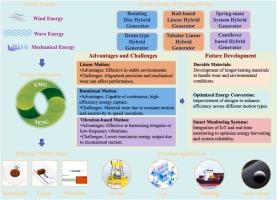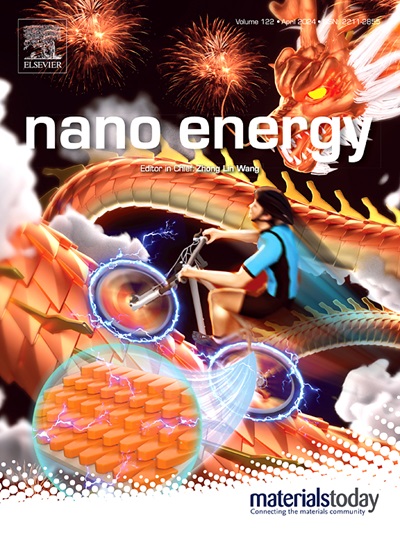Exploring the synergy of EMG and TENG in motion based hybrid energy harvesting
IF 16.8
1区 材料科学
Q1 CHEMISTRY, PHYSICAL
引用次数: 0
Abstract
This review paper explores the integration of electromagnetic generation (EMG) and triboelectric nanogeneration (TENG) technologies, emphasizing their classification based on motion types: linear, rotational, and vibration-based. By examining each motion type, we highlight the unique characteristics, advantages, and challenges associated with hybrid EMG-TENG systems. Linear motion devices are particularly effective in harnessing energy from predictable sources, such as ocean waves, demonstrating moderate power outputs suitable for marine applications. Rotational motion devices excel in environments with continuous high-speed motions, achieving higher energy outputs, especially in wind energy systems. In contrast, vibration-based devices capture energy from irregular and low-frequency movements, offering versatility for applications in vehicles and wearable electronics. The review also discusses recent developments in hybrid systems, showcasing advancements in materials and designs that enhance energy capture and efficiency. Despite the progress, challenges remain, including mechanical wear, environmental influences, and the need for precise alignment. By understanding the complementary nature of EMG and TENG technologies, this review highlights how their integration can address the limitations of each technology. EMG excels in capturing high-speed, continuous motion, while TENG is more effective for low-frequency and irregular motion, allowing hybrid systems to efficiently harvest energy in diverse environments. Ultimately, the findings suggest that the strategic integration of EMG and TENG technologies can contribute significantly to sustainable energy solutions, paving the way for innovative developments in energy harvesting.

探索肌电和TENG在基于运动的混合能量收集中的协同作用
这篇综述论文探讨了电磁发电(EMG)和三电纳米发电(TENG)技术的整合,强调了它们根据运动类型的分类:线性、旋转和基于振动的运动。通过研究每种运动类型,我们强调了与 EMG-TENG 混合系统相关的独特特征、优势和挑战。线性运动装置在利用海浪等可预测来源的能量方面尤为有效,其适中的功率输出适合海洋应用。旋转运动装置在连续高速运动的环境中表现出色,可实现更高的能量输出,特别是在风能系统中。相比之下,基于振动的设备可从不规则的低频运动中获取能量,为车辆和可穿戴电子设备的应用提供了多功能性。综述还讨论了混合动力系统的最新发展,展示了可提高能量捕获和效率的材料和设计方面的进步。尽管取得了进展,但挑战依然存在,包括机械磨损、环境影响和精确对准的需要。通过了解 EMG 和 TENG 技术的互补性,本综述强调了它们的整合如何能够解决每种技术的局限性。EMG 擅长捕捉高速、连续的运动,而 TENG 则对低频和不规则运动更有效,从而使混合系统能够在各种环境中有效地采集能量。最终,研究结果表明,EMG 和 TENG 技术的战略整合可为可持续能源解决方案做出重大贡献,为能源采集领域的创新发展铺平道路。
本文章由计算机程序翻译,如有差异,请以英文原文为准。
求助全文
约1分钟内获得全文
求助全文
来源期刊

Nano Energy
CHEMISTRY, PHYSICAL-NANOSCIENCE & NANOTECHNOLOGY
CiteScore
30.30
自引率
7.40%
发文量
1207
审稿时长
23 days
期刊介绍:
Nano Energy is a multidisciplinary, rapid-publication forum of original peer-reviewed contributions on the science and engineering of nanomaterials and nanodevices used in all forms of energy harvesting, conversion, storage, utilization and policy. Through its mixture of articles, reviews, communications, research news, and information on key developments, Nano Energy provides a comprehensive coverage of this exciting and dynamic field which joins nanoscience and nanotechnology with energy science. The journal is relevant to all those who are interested in nanomaterials solutions to the energy problem.
Nano Energy publishes original experimental and theoretical research on all aspects of energy-related research which utilizes nanomaterials and nanotechnology. Manuscripts of four types are considered: review articles which inform readers of the latest research and advances in energy science; rapid communications which feature exciting research breakthroughs in the field; full-length articles which report comprehensive research developments; and news and opinions which comment on topical issues or express views on the developments in related fields.
 求助内容:
求助内容: 应助结果提醒方式:
应助结果提醒方式:


